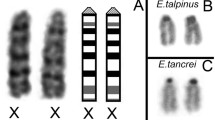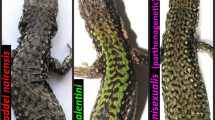Summary
-
1.
In the harlequin lobe of 21 species of Pentatomidae, the spermatogenesis always undergoes bizarre deviations from a normal meiosis.
-
2.
The deviations affect the meiotic pairing in most cases and also involve irregularities in the meiotic divisions which result in a highly variable number of chromosomes in the spermatids.
-
3.
There is good evidence that the chemical conditions within the harlequin lobe differ from those in normal lobes and that they are responsible for alterations in isopycnotic chromosomes that are most strikingly manifest in their mitotic behavior.
-
4.
Evidently the changed chemical environment has comparatively little effect on chromatin which is in the heteropycnotic state. Hence the mitotic behavior of the sex chromosomes in the harlequin lobe is normal, and autosomes that are predominantly heteropycnotic show less deviation from the normal than do isopycnotic chromosomes.
-
5.
The radically different behavior of chromosomes in adjoining regions of the same testis is a demonstration of the fact that chromosomal behavior is, to a considerable extent, determined by their immediate environment.
-
6.
The question of how so wasteful an organ as the harlequin lobe could have been evolved, is briefly considered.
Similar content being viewed by others
References
Ansley, H.: A cytophotometric study of chromosome pairing. Chromosoma (Berl.) 8, 380–395 (1957).
—: Histones of mitosis and meiosis in Loxa flavicolis (Hemiptera). J. biophys. biochem. Cytol. 4, 59–62 (1958).
Bonhag, P.: Histochemical studies of the ovarian nurse tissues and oocytes of the milkweed bug (Oncopeltus fasciatus). J. Morph. 96, 381–440 (1955).
—: Ovarian structure and vitellogenesis in insects. Ann. Rev. Entomol. 3, 137–160 (1958).
Bowen, R. H.: Notes on the occurrence of abnormal mitoses in spermatogenesis. Biol. Bull. 43, 184–203 (1922a).
—: Studies on insect spermatogenesis. IV. Proc. Am. Acad. Arts Sci. 57, 391–423 (1922b).
Cooper, K. W.: Cytogenetic analysis of major heterochromatic elements (especially Xh and Y) in Drosophila melanogaster, and the theory of “heterochromatin” Chromosoma (Berl.) 10, 536–588 (1959).
Martin, B.: Temporary elimination of the autosomes from the meiotic spindle in a halyinid pentatomid. J. Morph. 92, 207–239 (1953).
Montgomery, T. H.: The spermatogenesis of Pentatoma up to the formation of the spermatid. Zool. Jb., Abt. Anat. u. Ontog. 12, 1–88 (1898).
—: On the dimegalous sperm and chromosomal variation of Euschistus, with reference to chromosomal continuity. Arch. Zellforsch. 5, 120–146 (1910).
Nicklas, R. B.: Paper in preparation.
Ruckes, H.: Three new species of Mecistorhinus Dallas (Heteroptera, Pentatomidae). Amer. Mus. Novitates 1930, 1–8 (1959a).
—: New genera and species of pentatomids from Panama and Costa Rica. Amer. Mus. Novitates 1939, 1–18 (1959b).
Schrader, F.: Heteropycnosis and non-homologous association of chromosomes in Edessa irrorata (Hemiptera Heteroptera). J. Morph. 69, 587–607 (1941).
—: Regular occurrence of heteroploidy in a group of Pentatomidae (Hemiptera). Biol. Bull. 88, 63–70 (1945a).
—: The cytology of regular heteroploidy in the genus Loxa (Pentatomidae-Hemiptera). J. Morph. 76, 157–177 (1945b).
—: The elimination of chromosomes in the meiotic divisions of Brachystethus rubromaculatus Dallas. Biol. Bull. 90, 19–31 (1946a).
—: Autosomal elimination and preferential segregation in the harlequin lobe of certain Discocephalini (Hemiptera). Biol. Bull. 90, 265–290 (1946b).
—: A cytochemical analysis of the functional interrelations of various cell structures in Arvelius albopunctatus(deGeer). Exp. Cell Res. 1, 421–452 (1950).
—: The cytology and chemical nature of some constituents of the developing sperm. Chromosoma (Berl.) 4, 404–428 (1951).
Srivastava, M. D. L.: Compound sex chromosome mechanism and regularly occurring meiotic aberrations in the spermatogenesis of Macropygium reticulare. Cellule 58, 252–274 (1957).
Troedsson, P. H.: The behavior of the compound sex chromosomes in the females of certain Hemiptera. J. Morph. 75, 103–147 (1944).
Weber, H.: Biologie der Hemipteren. Berlin: Springer 1930.
—: Lehrbuch der Entomologie. Jena: Gustav Fischer 1933.
Wilson, E. B.: Studies on chromosomes. VIII. J. exp. Zool. 13, 345–449 (1912).
Author information
Authors and Affiliations
Rights and permissions
About this article
Cite this article
Schrader, F. Cytological and evolutionary implications of aberrant chromosome behavior in the harlequin lobe of some Pentatomidae (Heteroptera). Chromosoma 11, 103–128 (1960). https://doi.org/10.1007/BF00328648
Issue Date:
DOI: https://doi.org/10.1007/BF00328648




